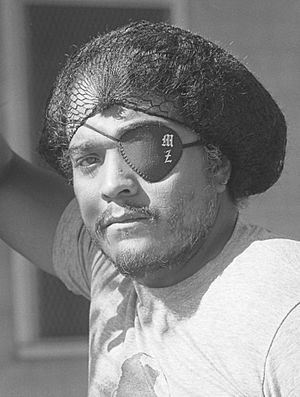Michael Zinzun facts for kids
Michael Zinzun (February 14, 1949 – July 9, 2006) was an important African American activist. He worked hard to stop police brutality. He was also a former member of the Black Panther Party.
Contents
Michael Zinzun's Early Life
Michael Zinzun was born in Chicago in 1949. He spent his early childhood in the Cabrini–Green neighborhood. He told the Los Angeles Times that his mother was Black and his father was Apache. His father passed away when Michael was eight years old.
After his father's death, Michael moved to Pasadena, California, to live with his aunt. He finished high school in Pasadena and lived there for most of his life. After graduating, he became a car mechanic. He even ran his own repair shop in Altadena. However, an oil company bought the land where his garage was. This meant Michael had to close his shop.
Fighting for Justice: Michael Zinzun's Activism
Joining the Black Panther Party and CAPA
In 1970, Michael Zinzun joined the Black Panther Party. He stayed for two years. He called his time there "an educational experience." He felt it helped him learn a lot.
In 1974, he teamed up with other activists in Los Angeles. These included B. Kwaku Duren and Anthony Thigpenn. Together, they started the Coalition Against Police Abuse (CAPA). This group helps people who have been treated unfairly by the police. They support victims and their families. They also protest and go to court to fight for justice. CAPA was inspired by the Black Panther Party. Many former Black Panther members joined CAPA.
Standing Up to Police Surveillance
Soon after CAPA started, the Los Angeles Police Department (LAPD) began watching them closely. The police used methods similar to those used by the FBI's COINTELPRO program. In 1983, CAPA led a lawsuit against the LAPD's Public Disorder Intelligence Division. This police unit had been spying on citizens. CAPA won the lawsuit. They received a money settlement, and the Public Disorder Intelligence Division was shut down.
Personal Battles and Lawsuits
In 1986, Michael Zinzun heard a loud noise from a violent arrest. He went to see what was happening. Police severely beat him during this incident. As a result, he lost sight in one eye permanently. After this, he famously said, "I'd rather lose an eye fighting against injustice than live as a quiet slave." He won a $1.2 million settlement from the police department because of what happened that night.
In 1989, he ran for a spot on the Pasadena City Council. During his campaign, the City of Los Angeles and an assistant police chief spread false information. They claimed Zinzun was being investigated by the police's anti-terrorism division. Zinzun sued them for spreading false information. He was first awarded $3.8 million. This amount was later changed due to a legal rule. After more appeals, Zinzun finally won $512,500.
Michael Zinzun's Later Work
After the 1992 Los Angeles riots, more people started paying attention to police brutality. Michael Zinzun and CAPA became more successful. By the 1990s, Zinzun was often a guest on local TV news. He wore clothes that showed his support for Black Power. He spoke in a direct and strong way. He always ended his appearances by raising his fist and saying, "Forward ever. Backwards never. All power to the people!"
Michael Zinzun had a press pass in Los Angeles. For about ten years, he hosted and helped produce a TV show. It was called "Message To The Grassroots." He worked with artist Nancy Buchanan on the show. They made about 100 episodes. The show talked about issues important to city communities. It aired on Pasadena Community Network's Channel 56. It also played on other public access TV stations in the U.S.
The show covered many topics. These included injuries caused by the Los Angeles Police Department K-9 dogs. They also discussed apartheid in South Africa and the start of Namibia. Famous actor Ossie Davis was a guest. The show also talked about conflicts between Black people and Latinos. It also addressed issues between different Black gangs.
Zinzun strongly supported a truce between rival Los Angeles gangs. He organized one of the first face-to-face truce meetings on his TV show. Members of the Bloods and Crips gangs met there. He also made a series of shows during the trial of police officers accused of beating Rodney King. These shows looked closely at video footage of the incident. Zinzun found a second camera that filmed King right after the beating. He showed this new footage to the world.
During the 1992 Los Angeles riots, Zinzun was on the streets. He filmed rare video footage of people looting stores. He also took cameras to Brazil and Namibia for episodes of his show. Zinzun filmed inside housing projects in South Central Los Angeles. These included Nickerson Gardens and Imperial Courts in Watts, Los Angeles. He talked directly with people living there about their communities.
Zinzun continued to work on community issues. He helped young people who were at risk. In his last years, he explored his interest in cooking. He studied at the Le Cordon Bleu school in Pasadena. Michael Zinzun passed away peacefully in his sleep in 2006.


